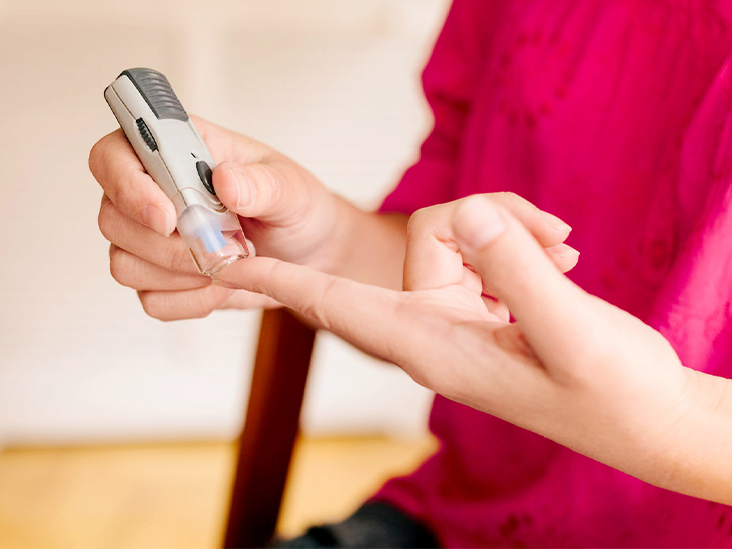Contents
What Are Diabetes Tests?
If you have diabetes, then it is important to test your blood sugar level to manage or control your diabetes. You can also test your diabetes at home only if it is not severely complicated. Otherwise, you will need to consult your doctor for proper diabetes tests if it gets serious. However, diabetes is a lifetime condition that cannot be cured completely. All you can do is manage or control it. You can also follow some tips to control your diabetes.
When it comes to diabetes control, blood sugar testing is really useful. It can assist you in the following ways:
- Keep an eye on how diabetes medicines affect blood sugar levels.
- Determine whether your blood sugar levels are high or low.
- Keep track of your progress toward your overall treatment objectives.
- Know about the effects of nutrition and exercise on blood sugar levels.
Now the question arises when to test your blood sugar level. So, your doctor will recommend when you should opt for a diabetes test. This usually depends on what type of diabetes you are having and what treatment you have opted for treating diabetes. If you have type 1 diabetes then your doctor will recommend testing diabetes 10 times per day.
On the other hand, if you have type 2 diabetes and you are taking insulin then he will recommend several times per day. Or if you are not taking insulin and following a diet while doing proper exercise then there is no need for any professional diabetes tests.
Who Should Get Diabetes Tests?
The doctor recommends diabetes tests for every person who is having diabetes symptoms or signs. However, people without diabetes symptoms should start their routine tests after the age of 45. Also, people with any of the following risk factors should also prefer tests:

- Sedentary lifestyle
- High cholesterol level
- Pre-diabetes (impaired fasting glucose)
- High blood sugar level
- Family history of diabetes
- Family history of Heart disease
- Women with gestational diabetes
- Polycystic ovarian syndrome
- High triglyceride level
For children and adolescents, testing should begin at an age of 10 years or when he/she enters in puberty level. Diabetes tests need to be repeated or taken after every 3 years. Children who are falling under the risk factors mentioned below should test for diabetes:
- Mother with diabetes
- Pre-diabetes signs
- Type 2 diabetes with family history
- Overweight
Undergoing diabetes tests will help you to control blood sugar levels. These tests are important because, with the increase in age, diabetes testing will help you in finding if you are having diabetes or not. So that you can prevent or control diabetes before getting into severe conditions.
What Level of Blood Sugar Is Dangerous?

If you have two readings of blood sugar around 300mg/dL or above in a row then your doctor highly recommends diabetes tests.
More than this reading in blood sugar level would mean dangerous for you. Or you can call your doctor if you find high blood sugar level symptoms.
High blood sugar level symptoms include:
- Constantly high blood sugar ratings
- Excessive thirst
- High level of sugar in the urine
- Again and again, occurring of urination
In general, the doctor recommends that blood sugar levels should not rise above 180mg/dL or the target that is set by your doctor. This too can be dangerous.
Blood Sugar Level Chart
| Time to check | Target blood sugar levels for people without diabetes | Target blood sugar levels for people with diabetes |
| Before meal | Less than 100 mg/dL | 80-130 mg/dL |
| 1-2 hours after the start of the meal | Less than 140 mg/dL | Less than 180 mg/dL |
| Over a 3 month period which an A1C test can measure | Less than 5.7% | Less than 7%Less than 180 mg/dL |
What Are Diabetes Test Methods?
Diabetes tests are important to know the amount of blood sugar level. The doctor will recommend a blood sugar test first to know whether you have diabetes or prediabetes. The food you eat such as grains or fruits contains carbohydrates that your body converts into glucose.
Glucose is used as a source of energy for our body. For diabetic patients, the following diabetic tests for type 1 and type 2 diabetes are highly recommended by the doctor:
A1c Diabetes Test

The A1c test is one of the most popular tests. It gives you an indication of your blood sugar levels over time. The glycated hemoglobin test is another name for the A1c test.
It determines how much glucose is linking to your body’s red blood cells over the last two to three months.
The A1c test examines your average blood sugar for three months. It is because red blood cells have a three-month lifespan. The test merely necessitates the collection of a modest amount of blood.
The A1c test may yield different results for different persons. This includes women who are pregnant or who have a haemoglobin variation that causes the test results to be erroneous. In some cases, your doctor may recommend a different type of diabetes test.
Random Blood Sugar Test

Random glucose testing is one method of determining glucose levels in the blood. A random glucose test can be performed by doctors at any time of day.
The body is always working to maintain optimal blood glucose levels.
To accomplish this, it creates the hormone insulin, which helps glucose to transport into the cells that require it for energy.
People with type 1 diabetes are unable to manufacture insulin because their immune systems target and destroy insulin-producing cells in the pancreas. Type 2 diabetes patients either don’t create enough insulin or their bodies don’t respond to it properly.
Moreover, glucose remains in the blood when a person does not produce insulin correctly. When blood sugar levels are persistently high, hyperglycemia occurs, and when they are consistently low, hypoglycemia ensues.
If the results show that a person’s glucose levels are higher than normal, the doctor will usually request a follow-up test to confirm the diagnosis. A random blood sugar test draws blood at any time, regardless of when you last ate. Diabetes is defined as a blood sugar level of 200 milligrams per deciliter (mg/dL) or above.
Fasting Blood Sugar Test

Blood is obtained after you’ve fasted overnight, which usually entails not eating for 8 to 12 hours. Moreover, fasting blood sugar testing include:
- Less than 100 mg/dL is normal.
- Prediabetes has a blood sugar level of 100 to 125 mg/dL.
- After two tests, a result of 126 mg/dL or higher indicates diabetes.
Oral Glucose Tolerance Test

The Oral Glucose Tolerance Test (OGTT) is a two-hour procedure. Firstly, your blood sugar will be check, and then the doctor will provide a sweet drink to you.
Moreover, your doctor will check blood sugar levels again after two hours and will consider the following points:
- Less than 140 mg/dL is normal.
- Prediabetes has a blood sugar level of 140 to 199 mg/dL.
- Diagnosing diabetes when the results are equal to or greater than 200 mg/dL.
What Test Are For Gestational Diabetes?

When a woman is pregnant, she may develop gestational diabetes. The researchers recommend that women with risk factors for diabetes should go for diabetes tests.
Doctors consider tests during their first appointment to see if they already have the disease. Gestational diabetes develops throughout the second and third trimesters of pregnancy.
To detect gestational diabetes, doctors may perform one of the two tests, mentioned somewhere below.
Risks Factors For Gestational Diabetes
Some of the following risk factors will help you to get to know when you should have gestational diabetes tests.
- Obesity and overweight.
- Less energetic while exercising.
- Diabetic during pregnancy or prediabetes.
- Polycystic Ovarian Syndrome (PCOS) (a kind of polycystic ovary syndrome).
- Family history of diabetes.
- Delivering a baby weighing more than 9 pounds in the past (4.1 kilograms).
Uncontrolled gestational diabetes can result in dangerously high blood sugar levels (hyperglycemia). High blood sugar levels can cause issues for both you and your baby, including a high probability of requiring a C-section delivery.
Screening Test For Gestational Diabetes
Your doctor may use some of these screening tests:
- Initial glucose challenge test- Doctors provide a glucose syrup solution during this test. After an hour, they monitor blood that is collected to check blood sugar levels. A blood sugar level of 130 to 140 mg/dL is normal. A reading that is greater than usual readings tells that more testing needs to check diabetes. If you have gestational diabetes, your doctor will request a follow-up test.
- Follow-up glucose tolerance test- You’ll be asked to fast overnight for the follow-up test, after which you’re fasting blood sugar level will be tested. The doctors determine a baseline blood sugar level. The expectant mother is then given a high-sugar solution to drink. After that, the doctor will monitor blood sugar every three hours. The results indicate gestational diabetes if a woman has readings that are higher than usual.
A two-hour glucose tolerance test, which is similar to the one above, is the second test. You’ll be diagnosed with gestational diabetes if at least two of your blood sugar readings are greater than the normal values established for each of the three hours of the test.
How To Test Diabetes At Home?

A glucometer is a device that is required to test blood sugar levels at home. A little, sharp needle called a lancet is used to prick your finger.
After that, a drop of blood is placed on a test strip, which is then placed into a meter that displays your blood sugar levels.
Make a note of the test results so you can tell your doctor about readings. Your diet, exercise, or medication needs to be managed as a result of your findings from diabetes tests.
Some meters determine an average blood sugar level over a period of time as well. Some models come with software kits that collect data from the meter and display graphs and charts of previous test results. At your local drugstore, you can get blood sugar meters and strips.
Some of the following steps you can follow while testing for diabetes at home:
- Wash your hands properly.
- In your meter, place a test strip.
- Use the lancet which your test kit provides to prick the side of your fingertip.
- Squeeze or massage your finger gently until you see a drop of blood.
- Touch the test strip’s edge to the drop of blood and hold it there.
- After a few seconds, the meter will display your blood glucose level on a screen.
A Word From MantraCare
Do you want to get rid of diabetes? Join our online diabetes consultation program and reverse your Diabetes naturally through lifestyle changes such as a Personalized Diet plan, Exercise, dieticians, and health coaches.


